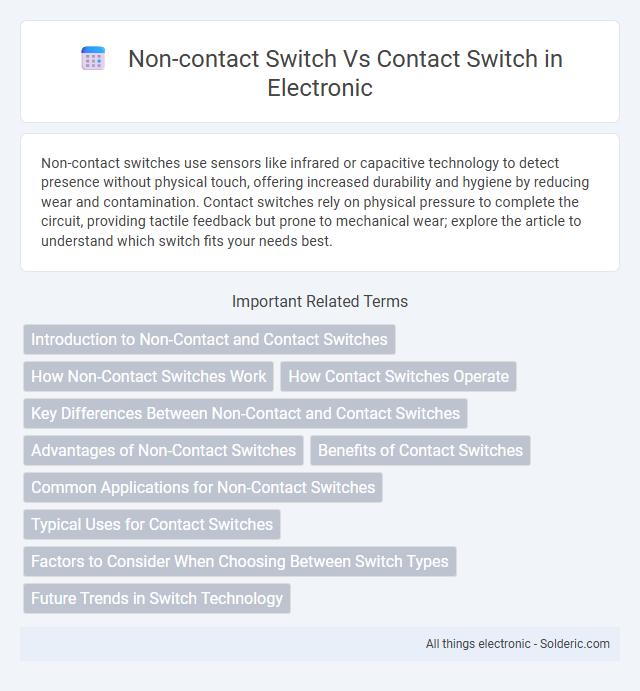Non-contact switches use sensors like infrared or capacitive technology to detect presence without physical touch, offering increased durability and hygiene by reducing wear and contamination. Contact switches rely on physical pressure to complete the circuit, providing tactile feedback but prone to mechanical wear; explore the article to understand which switch fits your needs best.
Comparison Table
| Feature | Non-contact Switch | Contact Switch |
|---|---|---|
| Operation | Activates without physical touch using sensors (e.g., infrared, capacitive) | Requires physical pressing to close electrical contacts |
| Durability | High, no mechanical wear | Moderate, prone to mechanical wear and tear |
| Hygiene | Superior, reduces contamination risk | Lower, contact surface can harbor germs |
| Response Time | Fast, immediate sensor detection | Fast, depends on mechanical action |
| Power Consumption | Typically higher, requires sensor power | Minimal, mechanical operation only |
| Installation Complexity | Moderate to high, needs sensor integration | Low, simple electrical wiring |
| Cost | Higher initial cost | Lower cost |
| Applications | Healthcare, automotive, clean rooms | Consumer electronics, appliances |
Introduction to Non-Contact and Contact Switches
Non-contact switches operate using sensors such as capacitive, inductive, or infrared technology, enabling activation without physical touch, which reduces wear and contamination risk. Contact switches rely on mechanical components like buttons or levers that close an electrical circuit through direct physical engagement, offering tactile feedback and simple installation. Both types serve distinct applications, with non-contact switches favored in hygiene-sensitive environments and contact switches commonly used where reliability and cost-effectiveness are prioritized.
How Non-Contact Switches Work
Non-contact switches operate using electromagnetic fields, infrared sensors, or capacitive sensing to detect the presence or movement of an object without physical touch. These switches offer increased durability and reduced wear since there are no mechanical parts that can degrade over time. Your choice of a non-contact switch ensures reliable operation in environments where cleanliness and longevity are critical.
How Contact Switches Operate
Contact switches operate by physically opening or closing electrical circuits through mechanical means, such as pressing a button or flipping a lever, which allows current to flow or stops it. The mechanical contact points inside the switch create a conductive path when engaged, ensuring reliable electrical connectivity. Your choice between contact and non-contact switches depends on factors like durability, response time, and environmental conditions.
Key Differences Between Non-Contact and Contact Switches
Non-contact switches operate using magnetic, capacitive, or optical sensors, eliminating physical wear and providing higher durability compared to contact switches that rely on mechanical movement and physical contact between components. Contact switches, often used in traditional applications, can be prone to mechanical failure and contact degradation due to friction and wear, whereas non-contact switches offer faster response times and increased reliability in harsh environments. Your choice between these switches depends on factors such as longevity requirements, environmental conditions, and precision in operation.
Advantages of Non-Contact Switches
Non-contact switches offer significant advantages such as increased durability due to the absence of physical wear and tear, resulting in a longer lifespan compared to contact switches. They provide enhanced reliability in harsh environments, as they are less susceptible to dust, moisture, and corrosion. Your systems benefit from faster response times and reduced maintenance costs with non-contact switch technology.
Benefits of Contact Switches
Contact switches offer reliable and straightforward operation with a simple mechanical design that ensures consistent tactile feedback and precise actuation. They provide excellent durability under repeated cycles, making them suitable for applications requiring long-term reliability without complex electronic components. The cost-effectiveness and ease of maintenance further enhance their appeal in industrial and consumer device settings.
Common Applications for Non-Contact Switches
Non-contact switches are extensively used in industrial automation, healthcare equipment, and consumer electronics where hygiene and minimal wear are critical. These switches employ technologies such as capacitive, inductive, or optical sensing, making them ideal for environments requiring durability and resistance to contaminants. Their application in touchless faucets, medical devices, and proximity sensors exemplifies their advantage over traditional contact switches in reducing mechanical failure and maintenance needs.
Typical Uses for Contact Switches
Contact switches are widely used in industrial machinery, home appliances, and automotive systems for their reliability in detecting physical positions or mechanical movements. Your equipment benefits from their straightforward design, providing consistent electrical connectivity in applications such as limit switches, door controls, and safety interlocks. These switches excel in environments where direct physical engagement ensures precise operation and dependable performance.
Factors to Consider When Choosing Between Switch Types
When choosing between non-contact and contact switches, factors such as durability, response speed, and environmental conditions play crucial roles. Non-contact switches, utilizing technologies like capacitive or proximity sensing, offer longer lifespans and superior resistance to dust and moisture compared to mechanical contact switches. Cost considerations and installation complexity also influence the decision, with contact switches being more economical but less suitable for harsh or high-frequency applications.
Future Trends in Switch Technology
Non-contact switches leverage technologies such as capacitive sensing and infrared detection, offering enhanced durability and reduced maintenance compared to traditional contact switches prone to wear and mechanical failure. Future trends indicate a shift towards integrating smart capabilities, including wireless communication and adaptive sensitivity, enabling more responsive and customizable user interfaces. Your choice of switch technology will benefit from advancements prioritizing efficiency, longevity, and seamless integration in IoT and automation systems.
Non-contact switch vs Contact switch Infographic

 solderic.com
solderic.com